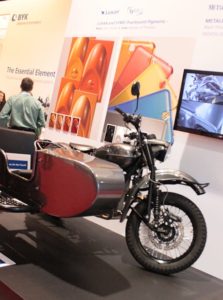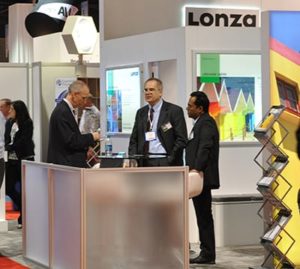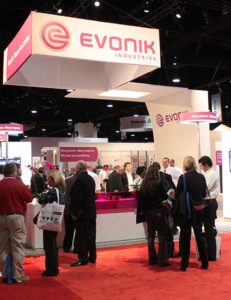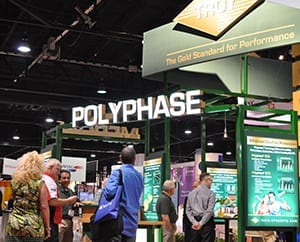Faced with an ever-increasing number of trade shows and conferences, potential attendees are seeking those that can provide the widest range of benefits. Offering a broad spectrum of knowledgeable attendees, high-quality educational sessions covering the latest advances in innovation, and clear opportunities for networking, the American Coatings SHOW (ACS) is now recognized as the leading event for the paint and coatings industry in North America. To be held April 12–14 in Indianapolis, IN, the ACS will draw representatives from coatings manufacturers and suppliers of raw materials, manufacturing equipment and instrumentation, and analytical and other services to discuss the latest market trends, regulatory expectations, formulation challenges, and innovative solutions. Expectations for the show are high and potential attendees have a strong level of interest in the new products and services developments to be presented.
Trade show participants generally arrive at a show with initial expectations about major market trends and issues. Valuable trade shows provide attendees—both exhibitors and visitors—with additional and often surprising insights into key market trends that are influencing marketing and development strategies. An informal survey of exhibitors has revealed several major themes that are expected be woven into the fabric of the 2016 event: sustainability, increased functionality, and improved performance. Underlying these trends is the increasing influence of customers’ expectations (vs. regulatory requirements) on innovation in the paint and coatings industry.
Seeking Sustainable Solutions
Sustainability in its many forms (elimination of VOCs, HAPs, and other toxic ingredients; increasing use of renewable raw materials; reduced waste; easier recycling; reduced environmental impact; greater manufacturing efficiencies, etc.) continues to be the key driver of product development. “We expect to see the introduction of new coatings that are compliant with the ever-growing and often complex mix of increasingly stringent regional, national and global regulations,” says Shauna McAuliffe, Americas marketing manager for Coatings at Air Products. Efforts are not just focused on regulatory compliance, however, and companies are still determining what aspects of sustainability on which to focus. “The real question is: What’s next after zero VOC?” asks Michael Guibault, industry marketing manager—Construction, from BASF Corporation’s Dispersions & Pigments Division, North America. “LEED and cradle-to-cradle certifications for paint are opportunities, as is the use of renewable raw materials and conducting lifecycle analyses, to demonstrate reduced carbon footprints. What is clear is that this space is incredibly complex to understand and influence,” he asserts.
Even so, the continued focus on incorporating green technologies into coatings to meet industry and consumer demands will support growth of added functionality, improved environmental footprint, and improved EH&S benefits, according to Sylvia Insogna, North America marketing manager for Dow Coating Materials. She does note, however, that being sustainable only gets you a seat at the table. Julie Fuell, North American Coatings sales director at Reichhold agrees: “We anticipate a continued push towards high performance, environmentally friendly, and cost-effective solutions to meet customer demands.” She points to the preference of contractors for the application and performance properties associated with traditional solvent-based products and their expectation of similar properties from more environmentally friendly alternative technologies. Interest is also increasing in product versatility, durability, and multifunctionality. For architectural coatings in particular, there is increasing customer focus on improving washability, dirt pickup resistance, and one-coat hiding.
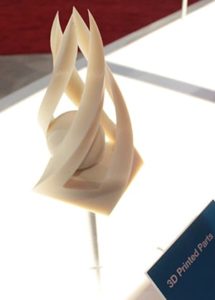 The continuing shift in the architectural segment from pro/contractor/wholesale to DIY reflects the growing importance of customer expectations. “From a performance standpoint, this shift is causing formulators to focus on coating characteristics that pertain to ease of application, while from a technology perspective, it is driving demand for low-VOC additives, functional coatings, and new polymer technology,” notes Julie O. Vaughn, vice president of marketing and business development for Emerald Performance Materials. Such a shift is a continuation of the trend toward innovation driven by consumer demand, and not just by regulations. The focus is no longer solely on VOCs. “Paint and coatings companies are now looking at customer needs like convenience and exploring opportunities to delight the customer and drive the customer to paint more,” states Guibault.
The continuing shift in the architectural segment from pro/contractor/wholesale to DIY reflects the growing importance of customer expectations. “From a performance standpoint, this shift is causing formulators to focus on coating characteristics that pertain to ease of application, while from a technology perspective, it is driving demand for low-VOC additives, functional coatings, and new polymer technology,” notes Julie O. Vaughn, vice president of marketing and business development for Emerald Performance Materials. Such a shift is a continuation of the trend toward innovation driven by consumer demand, and not just by regulations. The focus is no longer solely on VOCs. “Paint and coatings companies are now looking at customer needs like convenience and exploring opportunities to delight the customer and drive the customer to paint more,” states Guibault.
In addition to these specific industry trends, macroeconomic drivers are impacting the development of new paint and coating technologies. Fortunately, the U.S. paint and coatings market outlook continues to be favorable, driven by positive trends in the housing and automotive sectors and strong general consumer spending. On the other hand, the decline in oil and gas prices, and consequently production, may have adverse effects on demand. These drivers tend to influence both marketing and development strategies.
Connecting Technology with Market Demand
The American Coatings SHOW provides a great opportunity for attendees to see the technologies that are being introduced in response to the various factors that are impacting consumption of paints and coatings in various market segments. “The ACS is an opportunity to listen, learn, and share while we connect technology and innovation ideas with consumer demands and market drivers,” observes Murray Hemsley, global market segment leader at Eastman. He adds that ACS is a place where companies can nurture customer and industry relationships while remaining well-connected within the industry. Because the ACS brings together a unique and diverse demographic of people across the entire paint and coatings supply chain, from basic research through consumer marketing and everything in between, Insogna also believes that it plays an important role in idea sharing and drives collaboration efforts.
Of course, the show is a platform for exhibitors to introduce new products and technologies developed for the coatings markets and an opportunity to have face-to-face discussions with customers and prospects, according to Shenton King, director of marketing for King Industries. “As an exhibitor, we find that we have many opportunities to connect with existing customers and meet new customers who are continually trying to push the performance envelope or looking for some creative and value-added solutions to address a problem,” adds Vaughn. The location of the 2016 event is, according to several exhibitors, particularly conducive for attracting a much larger and more relevant cross-section of visitors. “A big part of the value of exhibiting will be connecting with the leaders of ongoing projects and receiving many new inquiries that will ultimately be converted into new projects,” notes Robert Ruckle, global marketing and sales manager for Siltech Corporation.
The ACS also provides an opportunity to introduce new business ventures. At ACS 2016, for instance, Sun Chemical will be presenting its Performance Pigments and Advance Materials product lines together for the first time. “The show allows us to demonstrate how we can provide a full range of resins and pigments that are tailor made for any coatings application,” says Americas global marketing manager, Coatings Michael T. Venturini. Air Products will also be formally introducing Versum Materials, its new Materials Technologies Business. New exhibitor Liquiglide, meanwhile, is looking forward to meeting with industry professionals and introducing them to the benefits of the company’s novel permanently wet, slippery surfaces that enable viscous liquids to slide easily.
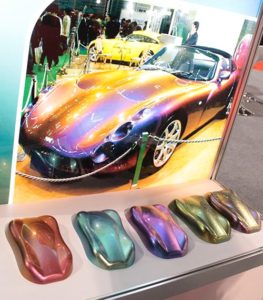 Still other exhibitors, such as equipment manufacturer NETZSCH Premier Technologies, laboratory services provider CHEMIR-EAG, and biobased specialty chemical manufacturer Green Biologics are looking to increase recognition and solidify their reputations for advanced technologies and solutions specifically designed to meet the needs of the coating industry, as well as build relationships with potential new customers. Reichhold is also hoping to draw attention to its biobased product offerings.
Still other exhibitors, such as equipment manufacturer NETZSCH Premier Technologies, laboratory services provider CHEMIR-EAG, and biobased specialty chemical manufacturer Green Biologics are looking to increase recognition and solidify their reputations for advanced technologies and solutions specifically designed to meet the needs of the coating industry, as well as build relationships with potential new customers. Reichhold is also hoping to draw attention to its biobased product offerings.
While the emphasis is on meeting with existing and potential customers, exhibitors also participate in the ACS to develop relationships with other types of visitors to the show. For Emerald Performance Materials, it is important as a co-supplier to the industry to make sure its products perform optimally in conjunction with the latest additive, pigment, and polymer technologies, according to Vaughn. Reichhold, meanwhile, is interested in meeting the newest professionals within the industry. “We feel that it is very important to have interactions between this new generation of paint chemists and seasoned industry veterans, because each brings a unique perspective, and such collaboration facilitates mutually beneficial results and relationships,” explains Scott Cooley, North American Coatings technology director for the company. He adds that these types of interactions, along with truly innovative products that will revolutionize the future of the coatings market, are the keys to success.
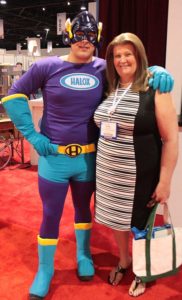 Overall, the American Coatings SHOW provides exhibitors with the opportunity to meet with a large number of customers and prospects to discuss technical and commercial challenges, exchange views on new products, and provide firsthand information about their product and application ranges, according to Juergen Loroesch, vice president, strategic account coordination, head of Paint & Coatings Industry team with Evonik. “We also use the ACS as a platform for expressing our commitment to the coatings industry through the development of solutions for surface modification, interface control and functional polymer design that solve our customers’ problems and help them stay ahead of industry trends,” he adds. Finally, the ACS offers companies a chance to glimpse into the future. “We attend the ACS in part to learn how the industry views itself moving forward and what it will focus on,” says Ahmed Tahir, industry marketing manager—Transportation, Industrial Coatings & Plastics with BASF’s Dispersions & Pigments Division, North America. He has hopes for the expansion of coating technologies that are cradle-to-cradle and the advancement of 3D coating systems.
Overall, the American Coatings SHOW provides exhibitors with the opportunity to meet with a large number of customers and prospects to discuss technical and commercial challenges, exchange views on new products, and provide firsthand information about their product and application ranges, according to Juergen Loroesch, vice president, strategic account coordination, head of Paint & Coatings Industry team with Evonik. “We also use the ACS as a platform for expressing our commitment to the coatings industry through the development of solutions for surface modification, interface control and functional polymer design that solve our customers’ problems and help them stay ahead of industry trends,” he adds. Finally, the ACS offers companies a chance to glimpse into the future. “We attend the ACS in part to learn how the industry views itself moving forward and what it will focus on,” says Ahmed Tahir, industry marketing manager—Transportation, Industrial Coatings & Plastics with BASF’s Dispersions & Pigments Division, North America. He has hopes for the expansion of coating technologies that are cradle-to-cradle and the advancement of 3D coating systems.
Promoting Performance and Functionality
The technologies, products, and services being highlighted at ACS 2016 certainly reflect both market trends and exhibitor ambitions. Suppliers are introducing a whole range of new resin, additive, and pigment systems designed to support more sustainable formulations, addressing issues ranging from manufacturing efficiency to renewable raw materials. There is also a strong focus on technologies that enable easier application and longer-term performance.
BASF’s Dispersions & Pigments Division is introducing a broad range of new products, including polymer emulsions, rheology modifiers, and specialty effect and high performance pigments. Acronal® PRO 80 na and Joncryl® RPD 980-B are designed for use in medium-duty anticorrosion primers and fillers for industrial metal coating applications and high solids polyurethane coatings with a practical pot life and rapid property development characteristics, respectively. Acronal 4247 is a very low-VOC, high performance dispersion for exterior wood coating applications, while Acronal 4750 is a paint and primer latex with excellent washability and superior stain blocking for architectural coatings. Tinuvin® 249 is a new, non-basic, liquid HALS that is compatible with a broad range of resins and offers migration resistance in polar epoxy-carboxy systems. New pigments include Paliocrom® Sparkling Red for an intense sparkling effect; Sicopal® Green L 9715, a PG50 that does not require carcinogenic labeling; Irgazin® Scarlet EH2096 (L 3553 HD), a new yellow shade PR255 for general industrial paint, powder, and architectural coatings; the universal, point-of-sale colorants PureOptions® High-Hide Yellow YE based on bismuth vanadate and PureOptions Blue BI based on indanthrone; and the newest product line: Lumina® Royal mica-based interference pigments for automotive and industrial applications with very high chromaticity that are available in shades from greenish blues through trending copper and oranges, including the newly launched Lumina® Royal Dragon Gold, as well as Magenta, Copper, Indigo, Aqua, and Blue.
Evonik will also be offering a broad portfolio of products, including resins, crosslinkers, and matting agents. DYNAPOL® polyesters for flexible packaging are BPA- and PVC-free, provide excellent adhesion to a variety of filmic substrates, and most are suitable for direct food contact applications. SILIKOPHEN® AC 950 silicone resin is designed for coatings with high-temperature resistance that cure at ambient temperature. For crosslinking, VISIOMER® 6976, a methacrylate monomer formulation, offers post-curing via UV- or daylight for tailoring of final application properties, while the VESTANAT® EP-M family of silane-urethane hybrid crosslinkers is designed for the formulation of multifunctional, scratch-resistant coatings usable on a variety of substrates. Evonik will also be highlighting matting agents for low-VOC coatings, including ACEMATT® 3600 for use in 100 % UV coatings and ACEMATT 3300 and OK 520 for waterborne systems.
Dow Coating Materials will be highlighting technologies that help its customers create distinctive offerings to meet and exceed their customer needs across a variety of markets and applications, including several that have been launched within the last few months and two that are being introduced at ACS 2016. Resin technologies include the MAINCOTE™ line of low-VOC, waterborne binders for direct-to-metal (DTM) industrial and transportation new build and maintenance applications and PARALOID™ resins for corrosion, chemical, and impact resistance, including PARALOID Edge 2K solventborne urethane technology that cures via an isocyanate- and formaldehyde-free mechanism; RHOPLEX™ 800h Binder for the formulation of low-VOC, binder rich, deep-toned paints that still have excellent hardness, tack, block, print and scrape resistance; and ROVACE™ 10 Vinyl Acrylic Emulsion, a 55% solids, APEO-free* and solvent-free* capable binder that offers excellent broad shear stability and good spray application and touch-up in formulations that meet multiple MPI specifications.
(*manufactured without APEO surfactants or solvents.)
Reichhold, meanwhile, is focusing on its low-VOC, high performance, waterborne resin technologies including BECKOSOL AQ® alkyd latex, UROTUF® urethane, and EPOTUF® waterborne epoxy systems to showcase the performance advantages that these products have over alternative resin technologies. Green Biologics will be emphasizing its 100% biobased and renewable n-butanol and acetone, which will be commercially available once the installation of the company’s Advanced Fermentation Process™ is completed at its site in Minnesota. “Unlike petroleum-derived products, our biobased n-butanol is isobutanol- and aldehyde-free, while our high purity acetone is benzene- and phenol-free. These benefits will allow our customers to significantly reduce their carbon footprint while increasing the renewable content of their products,” says David Anderson, global vice president of marketing for Green Biologics.
A number of additive suppliers will also be exhibiting at ACS 2016. Eastman will be offering a diverse portfolio including new polyester polyols designed to provide long-term weather resistance and appearance properties in automotive coatings and specialty ketones that provide formulating and processing advantages in high-solids, solventborne, compact automotive paint processes. According to a recent environmental lifecycle assessment conducted by the company, these products have an attractive sustainability position and can achieve low GHG impacts while meeting current emission limits. Eastman will also be offering its well-known Texanol™ ester alcohol coalescent and its newer Optifilm™ 400 enhancer that allows use of traditional polymer systems while still meeting stringent VOC and emission requirements. For the first time in 2016, Eastman will also be highlighting the neutralizing amine additives of its new subsidiary formed following the acquisition of Taminco US, including Eastman Vantex™-T and Eastman Advantex™, as well as TamiSolve™ NxG, a next-generation, high performing solvent with a favorable EH&S profile.
King Industries will feature new technology for coatings including NACURE® catalysts for low-temperature cure, K-FLEX® resin modifiers for improved hardness and flexibility with added benefits for VOC compliance, K-KAT® tin and mercury replacement catalysts, NACORR® corrosion inhibitors for direct-to-metal applications, and DISPARLON® rheology modifiers for waterborne systems. In particular, King will be introducing NACURE XC-315, an acid catalyst that promotes the crosslinking reaction of carbamate functional polymers with polyaldehyde crosslinking agents (isocyanate-free polyurethane coatings) at ambient temperature. Also to be featured are K-POL® 100% active diol modifying resins designed to enhance the performance of 2K polyurethane coatings, particularly K-POL 8211 for improving the performance of polyurethane floor coatings. “We have invested heavily in these new, environmentally friendly coatings in order to meet the changing needs of the industry and our customers,” says King.
Attendees at ACS 2016 will also find a wide range of advanced additive chemistries on display by Air Products through its new Versum Materials business. Newly launched products include Surfynol 107L, a liquid nonionic wetting agent and molecular defoamer that offers dynamic wetting along with knock-down defoaming for low and zero-VOC systems with low minimum film forming temperatures; Zetasperse 3800, a broad-utility dispersant formulated to provide strong stabilization of pigments, fillers, and other solids in aqueous dispersions; and Airase 4750V and 4800 vegetable oil and mineral oil-based defoamers, respectively, that are designed to control foam, bubbles, and entrapped air without generating surface defects. “Our goal at Air Products is to help customers optimize formulation performance, minimize reformulation time and effort, keep formulation costs under control, and/or find more environmentally preferred products,” says McAuliffe.
Emerald Performance Materials has a very broad portfolio of additive and resin chemistries designed to provide value- added solutions to performance challenges such as durability, blocking, and tack that are associated with the softer resins required in lower-VOC formulations. The Emerald Kalama Chemical business group will present new data that reports how K-FLEX® low-VOC coalescents provide better hardness than traditional high-VOC coalescents in direct-to-metal applications, as well as enhanced film formation, scrub resistance, and gloss. The Emerald Specialties Group will highlight its Masil® Ultra EXP3885 specialty silicone technology for slip/mar/scratch resistance in coatings and over-print varnishes. The CVC business group will feature EPALLOY®/HyPox™ epoxies with enhanced chemical resistance; ERISYS® reactive modifiers for enhanced durability; Omicure™ catalysts/accelerators; and HYPRO™ reactive liquid polymers, which are low-molecular-weight butadiene and butadiene acrylonitrile systems with reactive end groups to allow effective incorporation of a second phase of rubber particles into coatings. The Emerald Polymer Additives Business Group will feature the new medium-nitrile-level specialty emulsion Nychem™ 1561X604, a butadiene, acrylonitrile and styrene system with low/no emulsifier levels designed to enhance tensile strength, elongation, and abrasion, moisture, and chemical resistance.
Ashland will highlight its expanded line of Aquaflow™ nonionic synthetic associative thickeners (NSATs), which provide coatings with full gloss development, smooth finishes, drip and spatter resistance, and improved flow and leveling properties. Thickening efficiency is achieved with viscosity retention on tinting with universal colorants, making this additive well suited for premium paints formulated for the DIY market, commercial paints, and wood coatings. Ashland will also feature its Natrosol™ Plus rheology additives and its full offering of surfactants and defoamers.
From its full portfolio of silicone-based coatings additives and reactive silicones, Siltech Corporation will be highlighting its new low odor Silmer OH ACR products for 3D printing and other UV-cured niche applications where odor is an issue. The company will also launch a new class of materials designed to provide slip and antigraffiti properties without using CF2 chemistry. Additional product offerings include soft-touch materials and multi-functional products, according to Ruckle.
During the American Coatings SHOW 2016, Sun Chemical will build upon its recent announcement of a new Advanced Materials division by showcasing how some of the Advanced Materials product lines, such as polymers and PPS, can be utilized with its pigment products in a variety of coatings applications in the automotive, architectural, industrial, and plastics markets. The company will showcase a wide array of metallic pigments, including Benda-Lutz® MAXAL® grades for a bold metallic look and Benda-Lutz MAXAL EC encapsulated pastes with enhanced gassing stability in waterborne paints that provide improved resistance to alkali and acid staining without impacting the optical properties of the base aluminum flake, as well as its SunMICA® Exterior XC pearlescent special effect pigments designed for exterior coatings applications, particularly powder coatings. When MAXAL EC pastes are used with DIC CERANATE® polysiloxane-acrylic hybrid resins from Sun Chemical Advanced Materials, highly durable, stain-resistant, and self-cleaning coatings are obtained. These waterborne resins can be cured with DIC WATERSOL curing agent to produce clear or pigmented finishes with the same outstanding weather stability of fluoropolymer chemistries, according to Venturini. He also expects attendees to be interested in the company’s line of acrylic polymers designed for direct application to untreated polypropylene, which is attractive because it is lightweight and readily recyclable, but is difficult to coat.
Chromaflo Technologies will be emphasizing its integrated approach to product development and highlighting a number of its colorant options, including some of its colorant lines designed for architectural and industrial applications. For architectural coatings, the Colortrend® 808 line of low-VOC and APE-free universal colorants has minimal impact on paint properties and offers improved fade resistance and opacity in a broad color space. The low-VOC Colortrend 871 Series consists of pourable, cost-effective, highly concentrated, binder-free aqueous dispersions. For industrial applications, UCD® VXS colorants, which are formulated only with VOC-exempt solvents, are designed for use in low-VOC, solvent-based coatings. Chromaflo’s 897 and UCD® E line colorants enable effective tinting of water-based industrial coatings and meet stringent VOC guidelines. “Our core strength at Chromaflo is assisting customers in making the right selection to achieve the best balance between cost and performance, and the products we are highlighting at ACS 2016 are technologies designed in response to customer needs,” says CEO Scott Becker.
CHEMIR-EAG will highlight its analytical and product development services for the development, optimization, and evaluation of coatings. “These services can speed up a company’s product development program, because we function as extensions of our clients’ R&D departments,” says coatings specialist Scott Moore. CHEMIR-EAG also works with raw material suppliers to benchmark materials and develop new markets for existing materials. “We can leverage our analytical capabilities to reverse-engineer coating formulations, providing companies with a competitive edge for development and improvement,” notes senior technical specialist Ben Paulson.
Equipment manufacturer NETZSCH Premier Technologies will be presenting the latest generation of its mill and dispersion technologies for the coatings industry. The Alpha Media Mill has extremely high throughput rates, a significantly narrower dwell time distribution, and offers intensive grinding with uniform impact intensity, while the Epsilon inline disperser is a new, compact solution for producing homogeneous dispersions with reproducible quality in an inline process.
No matter what area of the coatings industry interests you most, opportunities will abound at the American Coatings SHOW to get a rare look into the future of coatings.

